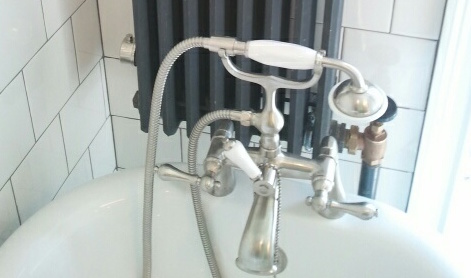Since launching this blog, the Handy Maniac has received calls, emails and messages via social media, requesting advice on specific repair issues. This made us realize we have made a critical error in our business model: We write and give advice for free.
Oh well. Chalk it up to our efforts to correct the image of the much-maligned contractor as a money-grabbing cheater.
Some day we will figure out how to get sponsors. Or one of those shows on DIY.
For now, we will continue to share HM’s know-how out of the goodness of our hearts.
Here are a few Q and As that we thought might be useful to others.
A Dripping Air Conditioner
Dear Handy Maniac:
We have one standing unit, I think the make is: Amcor. Eh. It's OK.
Then we have a window unit. A Kenmore. 12K BTU's. It's really good. Cools the whole downstairs pretty quickly.
But it drips outside. So what. All air conditioners drip. It's New York, we're used to it. But this one drips in such a way that it creates a puddle in front of the window of the guy on the first floor, whose apartment is a little beneath street level. The puddle eventually seeps into his wall, no matter what the building does to protect it. So, he has asked me if there's something I can do. Moving the air con to the other window isn't going to help because he has a window there, too.
So, what I'm thinking about is a pan that sits beneath the air con, on the window sill outside. Somehow, it's affixed to the sill—I don't know how. In one corner of this pan is a tube pointing away from the trajectory of the guy's window. I dunno, maybe the tube doubles back and then goes along the outside of the building? Whatever. Details. But the condensate drips into the pan and as the pan fills the water goes into the tube and away from my downstairs neighbor.
Does this seem insane? How would I do such a thing? Is there some easier way to solve this problem? I suppose I could just kill the guy, but I like him and he was our wedding planner.
Help.
Peter, NYC.
Dear Peter:
First, may I say I am impressed with your inventive solution. I suspect, however, there might be another way and so I am handing the keyboard over to HM….
HM here. Classic NYC prob. Funnels and trays and tubes are used all the time. Sometimes they work. Sometimes no. Try a drip line to a safer spot. Thick nylon twine starting at drip hole on AC and stretched to a low tree or gate post. Water will follow the line and fall off at end. Also: Make sure window and spacer screens around AC are SEALED TIGHT. Important. Make sure gap between windows has foam. Keep wet outside air away from AC intake. Cuts down on dripping. A lot.
OK, I’m back. That drip cord solution sounds even more wacky to me than your turkey roasting solution. But HM provided this photo to illustrate:
Note the string to divert the dripping water to the plant below.
Replacing a dripping faucet
Dear Handy Maniac:
OK, I have a bath faucet, one with a hand shower and one of those old fashioned telephone handles. Clearly the diverter is no longer diverting. It drips in both positions. The problem is, the faucet is made by an Italian company that no longer exists.
My question: Should I remove the faucet and try to find whatever valve is in there and see if I can find a compatible one? Or just buy a new $faucet$.
(Frankly, I am a bit nervous about removing the thing.)
Nervous in NYC.
Dear Nervous:
I had to ask HM what a “diverter” is but know I know: It is the thing that “diverts” the water from tub to showerheard. (see photo)
The diverter is that handle in the middle that diverts the water from the faucet to the telephone sprayer.
Here’s what HM suggests:
If you like the look and feel of the faucet, let’s try to save it first. It might just be a twenty-five cent washer that’s shot. You’re gonna have to take it apart. Know that your hot and cold shut-offs work, first. No slow drips. They must turn completely off. Start disassembling and pull out the stem. If that makes no sense, time to call a plumber.
Remember, if you’re working with chrome or brass nuts and washers, PROTECT THE METAL FINISHES with rags, tape, or smooth-faced wrenches. Work your way to the diverter washer, head off to the store and find a replacement for it. TAKE THE WHOLE DIVERTER COMPONENT WITH YOU. Most internal brass components will still be sound. It’s gonna be the rubber and nylon contact-points that have most likely failed.
I would like to add, that as a rule, once the water is off, HM usually changes ALL the washers on the hot, cold and diverter valves. (Otherwise known as Boy-Scouting it.)
NOTE to all readers: This is a unique fixture that Nervous in NYC is dealing with. MOST common tub and shower systems have replacement components you can buy. So you don’t have to “work your way to the washer” you can just replace the full stem with new washers included. It’s more than the price of a washer but it saves you a lot of headaches.
Choosing Insulation for a Home Renovation
Dear Handy Maniac:
Love the blog articles. We are remodeling a home down to the studs. I know spray foam is the "best" but not in the budget. I believe spray cellulose and batt insulation cost the same, would you recommend one or the other? Note: many of the rooms (including a large open great room/dining/kitchen) have vaulted ceilings.
Thanks!
Ben.
Hi Ben:
Thanks for reading the blog. Regarding your insulation question, HM sighs loudly, and then says:
I'd stick with batt, especially for the walls. I wouldn't recommend spray cellulose in wall cavities. I'd only recommend spray cellulose if you had attic access and flat ceilings, and could spray the cellulose from above. Remember your paper or foil vapor barrier (depending on your region) on your batts.
Good luck with your project!
Dear HM:
Thank you! We are in Phoenix. Would you tell me more about paper or foil vapor barrier? Do we need that in AZ? Never heard of it.
Ben.
Dear Ben:
You are starting to push your luck with all these questions. But you're right about it being a regional issue. Since you are in Phoenix, you don't need a vapor barrier- and shouldn't use it in hot or humid year-round weather. We are east coast so with all of the climate fluctuations it's something we have to use here.
Here is a good run-down from Lowe’s about different insulation options and when to use what.
Stay cool!
-HM.
OK, that's it for now readers. Feel free to send in questions or topics you'd like to see covered.




